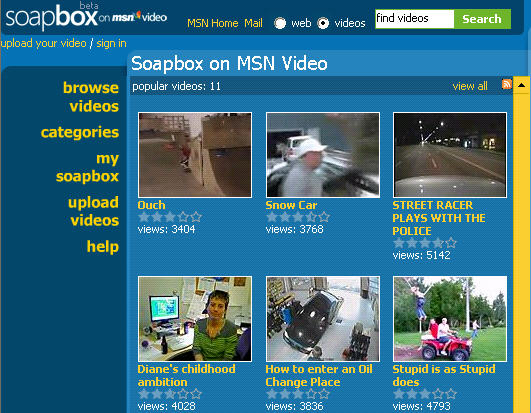I debated heavily before posting this, because this blog is supposed to be a review of the fun world of viral video and marketing (not an advertisement for my services). That being said, I think some of you readers may be interested in how I work with sponsors.
As you know, I advocate that brands participate in consumer-generated media, but many have invested hundreds of thousands, and have seen little in return. Here’s a presentation I recently gave for some clients of Atlanta-based interactive agency, Spunlogic. It takes you through a number of ways your brand can enter this space cost efficiently — from contests to partnering with known creators.
Background
Earlier this summer, I read The Secret. The big idea (while not being entirely new) is that you can attract things you want, if you ask for something and have an unwavering belief that it can happen. My day job as a Marketing Director pays well, but we live out of our means. So I decided to pursue an additional $4-$5,000 a month. And it’s been working. I’ve created several videos through XLNTAds and here’s a recent example for GPSManiac (it has nearly 40,000 views and was rated among the top videos of the day when it posted). I’m working on scheduling some promotional workshops because I believe most agencies and brands are still in the dark ages in this arena. October happens to be a slower month because a few of my promotional videos have been delayed to November and December.
So this month, I’m offering a “sale” for custom entertainment/promotional videos.
 You can promote your product or service for $2,000 flat fee (I’ve charged $1,500-$5,000). You’ll get a video you own for use on your own website, and a guarantee of no less than 20,000 views via my channels (I’m able to do that primarily thanks to YouTube). I perhaps should charge a higher premium because these are implied endorsements, and I don’t ever want to fatigue my kind, devoted viewers. But I enjoy making them and getting additional income. Two thousand dollars comes to no more than a dime a view, or $20 CPM (cost per thousand), which is the price YouTube charges for its new “InVideo” ads that appear briefly in the first 10 seconds of the video.
You can promote your product or service for $2,000 flat fee (I’ve charged $1,500-$5,000). You’ll get a video you own for use on your own website, and a guarantee of no less than 20,000 views via my channels (I’m able to do that primarily thanks to YouTube). I perhaps should charge a higher premium because these are implied endorsements, and I don’t ever want to fatigue my kind, devoted viewers. But I enjoy making them and getting additional income. Two thousand dollars comes to no more than a dime a view, or $20 CPM (cost per thousand), which is the price YouTube charges for its new “InVideo” ads that appear briefly in the first 10 seconds of the video.
I hope you can appreciate that I tend to be selective about the brands I promote. I typically avoid unknown startups, brands that don’t fit my personality, or anything to do with healthcare marketing (since that’s a conflict of interest). My favorite sponsor is Mentos (see Mentos example that they ran as an ad on Google Video and Break) because they are very hands off the creative and it’s a great brand. If you’re interested, please send a note to kevinnalts at gmail.com with the subject header “PROMOTIONAL VIDEO.” That ensures it gets my attention among the myriad of spam I get.
Here’s how it works:
- You present your brand’s goal, and any ideas you have. GPSManiac actually provided a script for this video (What GPS Thinks), but typically I create the concept and script.
- I brainstorm some ideas (3-12), and you decide what makes sense. For this to work, the video has to be entertaining first. Promotion needs to be subtle. Otherwise it won’t get views or good ratings. Since I’ve made more than 500 short videos and work in marketing, I can usually find a good intersection between promotion and entertainment.
- Once we settle on an idea, we flesh it out via an outline. Only when that’s approved by the sponsor will I shoot footage.
- I edit a draft (usually 1-3 minutes with a promotional message at the end and links to your site). You can make up to 3 revisions of the video. Ultimately I won’t post the video until we both believe it’s funny and achieves your marketing goal.
- I’m always transparent when it’s a promotional video. People think I do “product placement,” but I’ve never been paid by a sponsor for subtly incorporating their brand. It’s always clear if it’s a promotion.
- I upload the video to YouTube, and several other sites. I track the views and ensure that you achieve at least 20,000 views (but often more). GPS Maniac is using the video referenced above on its own, and paid less than a nickel a view via my channels. Not a bad deal.
- Note that promotional videos have limitations. They’re good for brand building, but they need to be entertaining since viewers will skip them or give them poor ratings otherwise. They also don’t typically result in instant conversion, so they aren’t yet a good direct-marketing play. I’ve found that a small (under 5%) number of viewers will actually visit the site mentioned, but I’m working on ways to drive that up. I’ve created a microsite for a client called “Mr. Complicated,” that I think will result in more visits from a video I’m currently editing.
As I’ve always said, anyone can get into this space. It helps when you have a sizable audience (I’m fortunate to have large following via YouTube) because that increases the views to your videos. At the same time, I have to walk a careful balance, because I never want to violate the trust of my viewers or promote so frequently that they stop watching.
I know some of my fellow YouTubers have also begun to do promotional videos (see Charles Trippy’s recent video which has already been viewed more than 75K times), and some have charged more or less. A few are new at this, and are happy to promote a fun brand in exchange for free product.
I look forward to your feedback. Do you think this is a fair deal? Any advice about ensuring brands meet their goals without compromising viewers experience? I want to hear from you. We’re still working things out on the WillVideoForFood forum, but that will eventually be a place we can compare and debate approaches.





